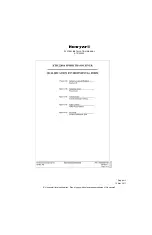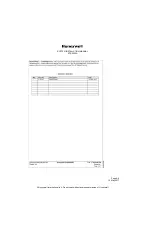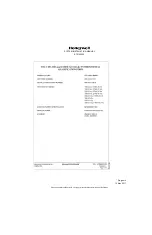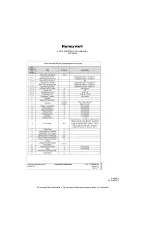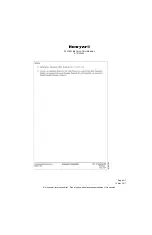
SYSTEM INSTALLATION MANUAL
KTR 2280A
Page 2-48
15 May 2017
© Honeywell International Inc. Do not copy without express permission of Honeywell.
16. Record the number of degrees by which the ADF bearing indicator has moved relative
the ADF indicator’s lubber line (This number must be a positive number and must be
approximately 270
°
.)
17. Confirm the value recorded in Step 16 is within ± 5
°
of 270°. If not, the aircraft has a
magnetic anomaly that precludes the ability to calculate an acceptable QE adjustment.
The QE alignment process must terminate at this point and not resume until the aircraft
related magnetic anomalies have been corrected. (Note: Problems with this step could
also be due to the airfield location where the QE alignment procedure is being per-
formed if that location is not magnetically “clean”.)
18. Using the aircraft’s directional gyro or magnetic compass as a guide, rotate the aircraft
another 45
°
to the left so that the aircraft magnetic heading is now 315
°
less than the
value found in Step 2.
19. Record the number of degrees by which the ADF bearing indicator has moved relative
to the ADF indicator’s lubber line. (This number must be a positive number and must
be approximately 315
°
.) Log this number as Bearing_315.
20. Using the following formulas, calculate the QE offset:
QE_45 = 45 - Bearing_45 (This could be a negative number if Bearing_45 is > 45)
QE_135 = Bearing_135 - 135 (This could be a negative number if Bearing_135 is <
135)
QE_225 = 225 - Bearing_225 (This could be a negative number if Bearing_225 is >
225)
QE_315 = Bearing_315 - 315 (This could be a negative number if Bearing_315 is <
315)
QE = ((QE_45) + (QE_135) + (QE_225) + (QE_315)) / (4)
21. Enter the value calculated in Step 20 into the KTR 2280A Parameter table per 2.5 KTR
2280A INSTALLATION PARAMETER MODIFICATIONS.
22. Recheck the relative bearings abd readjust the QE compensation as necessary to split
the error at the quadrantal points (45
°
, 135
°
, 225
°
and 315
°
) to obtain the lowest pos-
sible error.
(b) Operational Checks
The following operational checks are to verify proper operation of the
ADF function of the KTR 2280A and can be made with the aircraft in the parking area.
1. Place the ADF in the ANT mode and tune in several known stations. Verify that audio
reception is satisfactory and that volume control operation is normal. Verify that the
ADF indicator needle is parked at the 90 degree position relative to the noise of the air-
craft. Place the unit in the ADF mode and verify that the needle points to the station.
2. Select the BFO function to enter the BFO mode and verify that the BFO tone is present
in the receiver audio (if a keyed CW station is used the tone heard will be the coded
identifier).
2.4.2 KTR 2280A Post-Installation Flight Tests
2.4.2.1 COM TRANSCEIVER FLIGHT TEST
To check the COM transceiver, maintain altitude of at least 1500 feet and contact a ground station
facility at a range of at least fifty nautical miles. Contact a ground station close in. Disable the automatic
squelch and listen for any unusual electrical noise which would reduce the COM receiver sensitivity by
increasing the squelch threshold. If possible, verify the communications capability on both the high and
low end of the VHF COM band. Ensure that the COM mode selector is capable of individually selecting
all three modes (one mode at a time).
2.4.2.2 NAV RECEIVER FLIGHT TEST
To check the VOR/ILS system, select a VOR frequency within a forty nautical mile range. Listen to the
VOR audio and ensure that no electrical interference such as magneto noise is present. Check the tone


























